|
"It is estimated that approximately two million people in the UK have hearing aids which are capable of receiving, and could benefit from, audio frequency induction loop transmissions." The opening caption is quite frightening! After publishing a simple economical method of creating a hearing aid loop (see "An Economical Hearing Aid Loop") a request came through of how does one know when a loop is properly adjusted. After doing some serious scratching we managed to find, copy, and consolidate a few pieces of information and have presented them here. It is still strongly recommended that you employ one of the many firms that specialise in the installation of hearing aid loops if you are either embarking on installing or have trouble setting up such a loop in a public place (especially as it is now required by law - see below). If you are simply trying to get something to work for a dear friend or relative then the following should be able to help. We also found this bit on the legal standpoint: The UK Disability Discrimination Act states that "Any business or organisation providing a product or service to the general public must have an Induction Loop System fitted wherever information is verbally provided". Full implementation of this legislation must be completed by 31 December 2004. | ||||
| 1. HOW THE INDUCTION LOOP WORKS | ||||
|
The induction loop enables an audio frequency signal (such as speech) to be transmitted to a listener by means of a magnetic field (not electromagnetic, see below). This is done by causing a current to flow in a wire which then creates a magnetic field around the wire. This magnetic field is then received by a small coil within a hearing aid or other suitable receiver (the latter can usually be purchased at a much lower cost than privately dispensed hearing aids). The elimination of a direct sound path helps to reduce the interfering effects of distance and background noise which are particular problems for hearing aid users. The pickup coil in a hearing aid is usually selected by means of a switch marked 'M' for Microphone and 'T' for Telephone (the purpose of the coil within the hearing aid being originally designed to pick up the magnetic feild from a telephone earpiece). Sometimes a combined position is provided allowing simultaneous use of both microphone and coil. For hearing aid purposes only the magnetic field in the vertical direction is considered. This conforms with the general mounting direction of coils in hearing aids, however, if a listener bends his or her head then a change in sound level will almost certainly be noticed. Normally the listener should listen within the area of the loop. Beware the myths: There seems to be a myth floating about that claims such systems are 'specialised' as they are effectively radio transmitters. The term 'magnetic radiation' may have attributed to this! Although electromagnetic radiation can result from a loop, it is not the means of operation (in actual fact, the electromagnetic radiation is deliberately kept to a minimum as discussed later). The coupling mechanism between the loop and the hearing aid is purely magnetic. It does not involve any special 'transmitter' and 'receiver' and certainly not any form of radio or radio frequency. | ||||
| 2. THE LOOP ITSELF | ||||
|
The Loop comprises of one or more turns of insulated wire laid around the listening area at a suitable height. Maximum efficiency occurs when the loop is at the same height as the hearing aid although in practice the loop is often quite satisfactory fixed at floor level. Increasing the number of turns increases the field strength but 'coupling' between the turns may impair the transmission of high frequencies. Satisfactory results are usually best obtained from a loop with one or two turns of wire, although this largely depends on the size of the loop. | ||||
| 3. BASIC LOOP SYSTEMS | ||||
| ||||
| 4. MAGNETIC FIELD STRENGTH REQUIREMENTS | ||||
|
The most important part of setting up an induction loop is the strength of the magnetic field. Fortunately, international agreement has been reached on the most appropriate field strength for hearing aid purposes and this specification is the subject of a British Standard - BS 6083 pt.4: Magnetic field strength in audio induction loops for hearing aid purposes. The Radiocommunications Agency regulations covering the use of induction loops are aligned with the recommendations of this standard (as generating a magnetic field creates an electromagnetic field i.e. a radio wave). The recommended field strength is 0.1 amp/metre ±3dB measured at 1.2 metres above the floor - the level to correspond with the long term average level of a speech signal. However, the natural peaks of speech can exceed the average value by as much as four times and consequently the maximum field strength produced by the loop must be sufficient to meet these needs i.e. 0.4 amp/metre (+12dB). The particular value of field strength was selected on the basis of sensitivity tests on typical hearing aids and considerations of adequate (magnetic) signal to noise ratio. Before commencing a major installation it would be wise to measure the level of background 'magnetic noise'. In some situations this could be too high to permit the satisfactory operation of a loop. The recommended frequency range is 100-5000 Hz (±3 dB relative to the level at 1000 Hz). The standardised value of field strength should ensure that when a person listening through a hearing aid switches from 'T' to 'M' the sound of someone speaking normally should be about as loud as the signal from the loop. Any gross departure from the recommendation could result in an unsatisfactory system. How this field strength relates to amplifier output requirements will be covered in a later section. Note: Although a certain level of electromagnetic radiation emits from a hearing aid loop, a licence is not required to operate such a loop. The Radio Communications Agency does, however, require that these systems conform to the field strength requirements laid down in BS 6083 part 4 (especially the frequency range!). There are two areas that need to be concentrated on to keep such radiation in check. The first is the amp must be 'stable' i.e. the attachment of the loop must not cause the output stages of the amp to 'take off' (spuriously oscillate). Such frequencies are usually inaudible and could be high enough to tell a jumbo jet that your site is a runway! Tests can be carried out to ensure this is not occurring. The second is the frequency range capability of the amplifier often exceeds the regulation limit of 5kHz. Most power amplifiers use "direct feedback" for the tone controls (the speaker output is fed directly back to the input via the tone control circuit). This has the value added effect of ensuring the output is relatively pure. By simply turning the treble control slightly to the "cut" side (usually anti-clockwise) will ensure the amp limits the high-frequency output. Using a too-small amplifier (i.e. not enough muscle) results in the amp distorting. Such distorting is technically referred to as the amplifier lacking 'headroom' resulting in the output waveform being 'clipped'. The situation is aggravated as this waveform, now rich in harmonics through the clipping, is fed into an inductive loop which can act as an antenna. Speech average-to-max ratio is about 4. So, to minimise clipping, the amplifier should be able to deliver a minimum of 4 times the required average output i.e. +12dB These issues are dealt with in more detail in sections 6 & 7 below. Please read them carefully. | ||||
| 5. CALCULATING THE REQUIRED CURRENT | ||||
|
The following analysis relies only on calculations of current. Magnetic field strength is proportional to current flowing in the loop and consequently 'power' is required only to overcome the resistance of the loop wire. As large loops, or loops with several turns (N), have relatively high values of inductance (proportional to N2) problems exist in the maintaining the magnetic field strength at the higher frequencies - not that this, in itself, is a bad thing seeing as one does not want to 'talk' to Jumbo jets, as mentioned above! This is where the application specific amplifiers come into their own with the feedback control based on current and not voltage as with normal speaker amplifiers. Although this point should be considered, it has not been included in this analysis. The following will assist in deciding the type and 'size' of amplifier required. AMP/METRE: A field strength of 1 amp/metre (1A/m) exists at the centre of a circular loop of one metre diameter when a current of one amp flows in the loop. These following calculations relate to simple loop shapes, squares and rectangles and are quite satisfactory for most applications.
which means that a field strength of 0.1A/m would be given by a current:  One can use multi-turn loops to reduce the required loop current i.e. with two turns wired in series the required current will be one half of the calculated value. But, as shown above, do not go too wild as too many turns drastically reduces the upper frequency response.
Within the confines of the loop, the field is weakest at the centre rising to higher values as the wire is approached. Over the wires a sharp reduction occurs in the vertical field strength leading to a perceptible but decreasing field outside the loop. This 'overspill' may present serious problems if other loops are operated in proximity.
| ||||
| 6. LOOP AMPLIFIERS | ||||
|
There is a line used by marketers of hearing aid loop amps claiming that PA amps cannot be used for this purpose. In some respect they are correct, however, it is more a marketing line than a technical reason - we expand on it here. Standard amps (i.e. used to drive speakers) are termed 'voltage amplifiers' and will output a voltage at a fixed ratio to the input voltage, regardless of the output impedance. The hearing aid loop will have some inductive component meaning the impedance will rise with frequency. Therefore, as the voltage is constant, the current flowing in the loop will reduce the higher the frequency. Loop amps compensate for this by varying the output current at a fixed ratio to the input voltage. This means at higher frequencies the amplifier automatically compensates for the higher impedance by ensuring the current is maintained. What the technical boffs, who want you to buy their loop-specific amps, don't tell you is the inductive component is actually not as much as what they would have you believe. This characteristic is easily compensated for using what every good PA amp should have... Tone Controls! By cutting the bass and boosting the treble (although we do advise against this throughout this paper), the loop's characteristic impedance vs frequency curve is easily corrected. What the boffs also don't tell you is it is advised to not have frequencies above 5kHz enter the loop in fear of starting to radiate very low frequency radio waves (as is, the hard of hearing battle to hear high frequencies). However, having a voltage amp feeding a loop whose impedance rises with frequency means that at the higher frequencies there is less current flowing which means less chance of radiating. Both the above issues are very easily dealt with using an equalizer - and don't splash out, a cheap one will do the job nicely. The controls can slope upwards from low frequencies to the one closest to 5kHz (this compensates the loops frequency response) with the top frequencies being cut completely (to stop radiation above 5kHz). This is especially attractive if using a 'speaker driver' amp (line in, speaker out, and fitted with nothing more than a gain control). It is not advocated that loop-specific amps not be used. Far from it! What is being said is; where there is a calling for a decent loop amp, such as a public auditorium that has a daily audiance, then by all means pay the price. But when it comes to cash-strapped institutions and charity based organisatons, then using an old PA amp is a lot better than having nothing at all! However, such an amp should be capable of driving a low output load impedance - typically 4 ohms or less. Other features such as automatic gain control (AGC) and compression make the output more useful to the hearing impaired. Please also pay specific attention to section 7. If an amp specifically designed for driving Hearing Aid Loops is chosen, then several types of are available. These reduce the need for having a gauge of loop cable which reasonably matches the amplifier output characteristics. They also usually include metering of input and output signals, compression, AGC, and a limited frequency response bandwidth so as to comply with licensing regulations. Most manufacturers give details of cable gauge requirements for various sizes of loop and useful design and installation guidelines. | ||||
| 7. MATCHING THE LOOP AND AMPLIFIER | ||||
Before we continue, I would like to again revisit a salient point; Because the natural peaks of speech can exceed the average value by some 12dB, the short term maximum current requirement from the amplifier will be a minimum of four times the average value. This means the required loop current, as determined in section 5, must be multiplied by 4 before determining the required amplifier power output.
The total resistance of the loop will also influence the power output requirements of the amplifier. For example, if the loop has a resistance of 4 ohms and requires a current of 2.5 amps then an amplifier capable of working into a minimum 4 ohm load will be required, with a minimum power output of I2R = 2.52 x 4 = 25 watts. If, however, the resistance of the loop is higher than this, an amplifier with a higher output rating would be needed even if it were matched to the resistance of the loop. This may not be very important for small loops but on large installations the difference could be significant. Most good quality public address style amplifiers have a 100 volt line output which can be matched to almost any loop with a suitable step-down transformer. In some buildings it may be necessary to install the loop amplifier some distance from the loop itself. In this situation it can be advantageous to use the 100 volt line output and place the step-down transformer in a convenient position close to the loop. This avoids running long cables carrying high audio currents. This also has the added advantage of limiting high-frequency radiation as audio transformers start limiting transfer of signals above approximately 10kHz. Please use a dedicated amplifier for the loop. Don't wire the loop in parallel with the loudspeakers of a sound system as any alteration to the sound level of the loudspeakers will result in a similar change in the magnetic field from the loop. This will make it impossible to meet the required field strength with such systems. This amplifier, if fed from a mixing desk, should be ahead of the main output controls (using a dedicated "send" channel would not be a bad idea at all). | ||||
| 8. PRACTICAL ISSUES | ||||
|
Sometimes it is impractical to lay the loop where it would be most effective and the ensuing problems of fitting the loop may make the task more difficult and expensive. For example, inside churches, stone construction is often met and wires may need to be hidden from view. Such matters can only be resolved by agreement, and a suitable compromise should be sought taking into account all the relevant factors. Small deviations around doors and windows should not disturb the field appreciably and are often unavoidable. These practical considerations may well account for the largest part of the work involved in fitting the loop. | ||||
| 9. MICROPHONES AND OTHER INPUTS | ||||
|
Where a satisfactory sound system is already installed the loop amplifier can be fed from the mixer or pre-amplifier stage of the system. This will save on duplication of microphones if these have been well chosen and sited in the first place but still gives independent control of signal from the loop. In the absence of an existing sound system it will be necessary to provide microphones and inputs to the loop amplifier for any other signals. When microphones are to be used it is vital that they are positioned to pick up sound which is free from reverberation and other noises. If a poor signal is received by the microphones then the signal transmitted to the listener will be poor no matter how good the design of the loop and other equipment. It is also necessary to ensure the microphones are matched electrically to the amplifier so that it is 'driven' adequately when the loop is in operation. It is important to consider the loop itself as forming an integral part of a sound system. A British Standard Code of Practice for the 'Planning and Installation of Sound Systems', BS-6259, gives valuable information to engineers on various design aspects of such systems. | ||||
| 10. EVALUATION | ||||
|
It was mentioned earlier the value in checking background 'magnetic noise' levels, especially in places where a high level is likely. Lighting control equipment may present a problem and so the tests should be made under typical conditions. Once the initial design has been completed a trial with the loop in place but not permanently installed should be considered. If the installation is straightforward and the various technical matters have been resolved, a trial may not be needed. When there are uncertainties (for instance, when individual rows or blocks of seats are being looped and weak spots are likely) preliminary tests may prevent the permanent installation of an unsatisfactory system. Although listening tests are an important part of the test strategy a quick check with a hearing aid is an adequate test of a system. The points which can be checked in this way are clarity of speech and freedom from interference, and these points should be checked at all important locations. Other tests require the use of measuring instruments. The most useful is a field strength tester which can be bought at reasonable cost. The instrument should be calibrated over the required frequency range. This, together with a meter to measure the AC current in the loop and perhaps an oscilloscope to examine the waveform, would provide sufficient equipment to check the connect operation of the loop. A most important point to watch for once the system has been adjusted to the correct operating level is the possibility of interference on other systems such as musical instrument pick-ups. Such inadvertent interference could create a form of feedback that is extremely difficult to trace (and sometimes to even be aware of especially if beyond hearing range). If the field strength given in BS 6083 pt.4 is regarded as a target value the level will be suitable for most hearing aids in current use. If the signal to noise ratio is adequate and a good clean signal is fed to the loop, then the system should be satisfactory for the great majority of hearing impaired people using appropriate hearing aids.
© 14.11.02 |
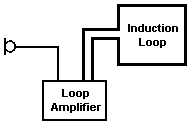
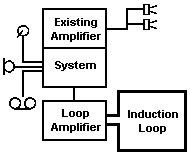
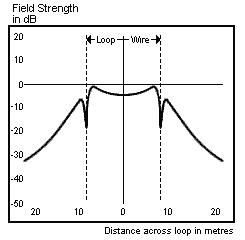 Naturally this calculation gives the field strength only at the centre of the loop but we need to know about the distribution of the field over the whole area of the loop. The next diagram shows how the field at ear level of a seated listener will vary across a loop 15m x 15m, if it is assumed that the loop is laid at floor level. The analysis is based on equations from standard magnetic theory (which are too long to go into here).
Naturally this calculation gives the field strength only at the centre of the loop but we need to know about the distribution of the field over the whole area of the loop. The next diagram shows how the field at ear level of a seated listener will vary across a loop 15m x 15m, if it is assumed that the loop is laid at floor level. The analysis is based on equations from standard magnetic theory (which are too long to go into here).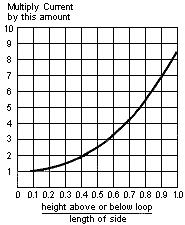 EFFECT OF HEIGHT
EFFECT OF HEIGHT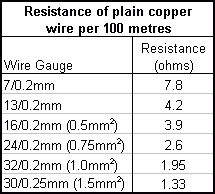 The gauge of wire used to form the loop will depend on the total length needed and the resistance required. Preferably the total resistance of the loop should be equal to or slightly above the minimum output load value of the loop drive amplifier as stated by the manufacturer. The wire table can be used to find the appropriate gauge of wire.
The gauge of wire used to form the loop will depend on the total length needed and the resistance required. Preferably the total resistance of the loop should be equal to or slightly above the minimum output load value of the loop drive amplifier as stated by the manufacturer. The wire table can be used to find the appropriate gauge of wire.